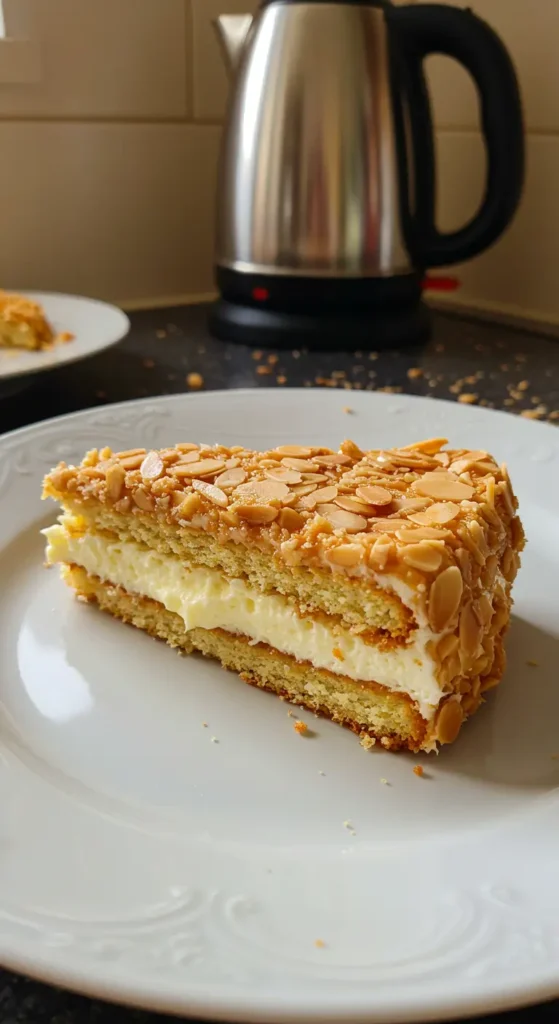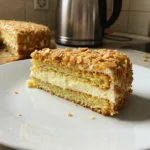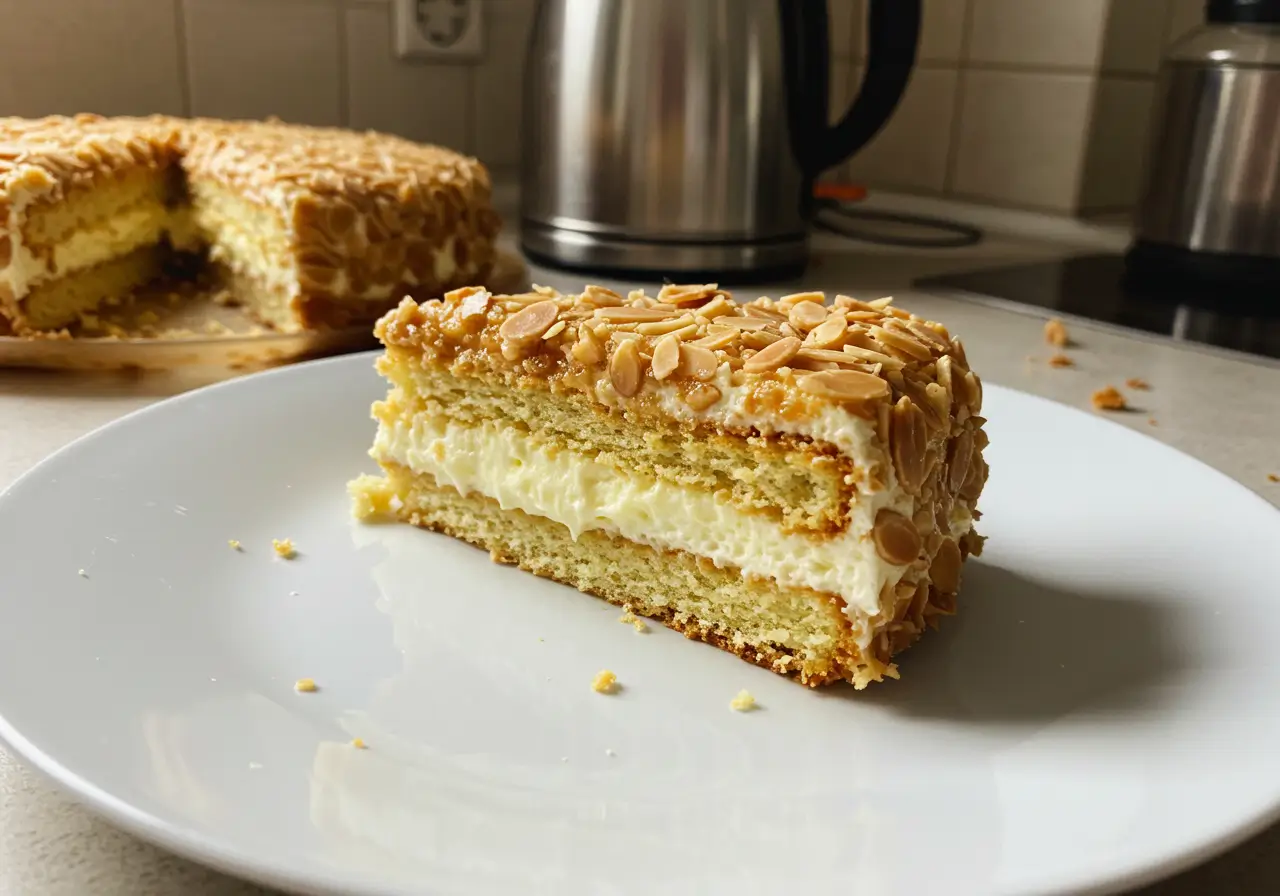Bienenstich Dessert
Table of Contents
There’s something magical about a cake that strikes the perfect balance between crunchy and creamy — and Bienenstich Dessert does exactly that. Also known as the German Bee Sting Cake, this iconic treat has deep cultural roots, irresistible flavor layers, and a texture that dances between soft and crisp.
In this guide, we’ll explore everything there is to know about this beloved dessert — from its curious name to how to make it perfectly at home. Whether you’re a passionate baker or just someone with a sweet tooth, you’ll discover step-by-step instructions, flavor variations, cultural tidbits, and insider tips to help you master Bienenstich Dessert.
Let’s begin with a quick look at its origins and why this honey-kissed beauty earned such a stinging name.
Traditional Ingredients and Flavor Profile

Signature Components: Yeast Cake, Cream, Honey-Almond Topping
At the heart of Bienenstich Dessert is a harmony of three simple yet powerful layers. First comes the yeast-based cake, which gives this dessert its fluffy, bread-like texture. Unlike sponge cake, this layer has more chew — a perfect base for what comes next.
Then there’s the vanilla cream filling, tucked snugly in the middle. It’s rich, smooth, and slightly sweet. This layer brings balance to the bold topping, adding a creamy contrast that melts on the tongue.
And finally — oh, the topping! A golden crown of caramelized honey and sliced almonds, crisped just right in the oven. That bit of crunch with each bite? Pure bliss. Together, these elements define the unique flavor and texture of the traditional Bienenstich Dessert.
Flavor and Texture Combinations That Make It Special
What makes this cake truly unforgettable is the contrast. The yeasty base has a mild, subtle taste. The cream filling adds silky sweetness. Then the honey-almond topping swoops in with a crunchy, nutty finish. Every bite delivers soft and crunchy, mild and sweet — all at once.
Because of this delightful mix, the Bienenstich Dessert is unlike any other cake. It’s no wonder it’s still a favorite at German bakeries and homes alike.
Step-by-Step Guide to Making Bienenstich Dessert

Preparing the Yeast Dough Layer
Let’s roll up our sleeves! Start by combining flour, sugar, salt, and instant yeast in a bowl. Add warm milk, a whisked egg, and melted butter. Mix until it forms a soft dough. If it sticks too much, sprinkle a bit more flour.
Now, knead the dough for a few minutes until it’s smooth. Let it rest in a warm spot for 30 minutes. This short rise time helps keep the base light and airy — just what Bienenstich Dessert needs.
Once it’s rested, press the dough evenly into a greased 8×8 inch pan. Prick it gently with a fork to prevent bubbles.
Making the Honey-Almond Topping
While the dough rises, melt butter, honey, and sugar in a small pot. Add a splash of cream and stir until smooth. Remove from heat and fold in the sliced almonds.
Pour the almond topping over the dough and spread it gently with a spatula. Be sure it covers every corner. Now, bake it at 350°F (176°C) for about 30 minutes — or until the topping turns golden and crisp.
Creating the Perfect Cream Filling
While the cake cools, it’s time for the filling. Whip cold heavy cream with vanilla pudding powder and vanilla extract (or vanilla sugar) until soft peaks form. Taste and adjust for sweetness. Then beat again to firm peaks. Pop it into the fridge to set while you prep the cake.
Assembly Tips and Tricks for Success
Here’s a pro tip: slice the cake before you add the cream. Once the cake cools, cut it in half horizontally with a serrated knife. Then, slice the top layer (with the almond crust) into nine pieces.
Spread the cream evenly over the bottom layer. Carefully place each almond-topped piece on top. This way, when it’s time to serve, you won’t smash the filling or crack the topping.
Chill the whole cake for at least an hour before slicing and enjoying. Trust us — the wait is worth it. And just like that, you’ve made your very own Bienenstich Dessert!
For more traditional German bakes, check out this fluffy Baked German Pancake — it’s simple, puffy, and packed with comfort.
Serving and Storing Tips
Best Time to Serve Bienenstich Dessert
Timing is everything. Bienenstich Dessert is best enjoyed the same day it’s made — ideally a few hours after chilling. That’s when the cream sets beautifully and the almond topping still has that golden crunch.
Serve it slightly chilled, not ice-cold. This helps the flavors shine and the texture stay perfect. Pair it with coffee or tea, just like the Germans do during their cozy Kaffee und Kuchen (coffee and cake) tradition.
How to Store Leftovers Without Losing Texture
Got leftovers? Pop them in the fridge in an airtight container. They’ll keep for up to 2 days, but the topping might soften. To keep that lovely crunch, store the top layer separately if possible and reassemble before serving.
Avoid freezing — the cream filling can separate, and the texture takes a hit. Honestly, this cake is so good, leftovers rarely stick around!
Bienenstich-Inspired Desserts and Modern Twists
Bienenstich Ice Cream, Cupcakes, and More
Why stop at cake? Bakers around the world have turned the classic Bienenstich Dessert into a variety of playful treats. You’ll find it reinvented as cupcakes, layered trifles, parfaits, and even ice cream! These versions keep the spirit alive — a mix of honey, almonds, and cream — but offer more ways to enjoy it.
Cupcake versions use sponge cake as a base, filled with light cream and topped with crunchy almond shards. They’re perfect for parties and bake sales. Meanwhile, Bienenstich ice cream blends crushed almonds, vanilla cream, and a ribbon of honey. Every bite brings that familiar flavor in frozen form.
These fun twists are perfect when you want something fresh but still crave that nostalgic taste.
Vegan and Gluten-Free Alternatives
Don’t worry if you’re avoiding dairy, eggs, or gluten — you can still enjoy a version of this sweet treat. To make a vegan Bienenstich Dessert, swap in plant-based milk and butter, use egg replacers, and try coconut cream for the filling.
For gluten-free bakers, almond flour or a good gluten-free blend does the trick. Just be sure to check your pudding mix and toppings for hidden gluten. With a few smart swaps, everyone can savor this German classic.
Where to Buy Bienenstich Dessert or Ingredients
Online German Bakeries and Local Stores
Can’t bake it yourself? No worries — many online bakeries ship Bienenstich Dessert straight to your door. Look for authentic German food stores that carry traditional sweets. Some even offer seasonal or regional varieties for an extra-special treat.
You can also check with local European bakeries, especially those specializing in German, Austrian, or Swiss pastries. Some delis or international grocery stores stock frozen versions that just need thawing.
Ready-Made Bienenstich Mixes: Worth It?
If baking from scratch feels like too much, consider a boxed Bienenstich Dessert mix. These kits typically include the dry ingredients for the cake and topping — all you do is add butter, milk, or cream. While not quite as rich as homemade, they’re a handy shortcut when you’re short on time.
They’re also a fun way to get started before trying the full traditional recipe later on. For beginners, they strike a sweet balance between convenience and flavor.
Bienenstich Dessert in German Culture and Cafés
The Kaffee und Kuchen Tradition
In Germany, desserts are more than just sweet treats — they’re part of a beloved ritual called Kaffee und Kuchen. Every afternoon, families and friends gather for coffee and cake, often around 3 or 4 p.m. It’s not just about food; it’s about slowing down and connecting.
The Bienenstich Dessert fits perfectly into this tradition. Its light cream and honeyed crunch pair beautifully with a hot cup of coffee. In many German households, this dessert often takes center stage during weekend gatherings or special celebrations.
How Germans Enjoy Bienenstich Today
Even today, Bienenstich Dessert remains a bakery favorite across Germany. Whether you’re in a big city or a small village, chances are you’ll find a slice waiting in the display case.
Many Germans still prefer to buy it from their local Konditorei (pastry shop), while others enjoy baking it at home using recipes passed down for generations. Either way, it’s a dessert filled with both flavor and fond memories.
Expert Baking Tips for a Perfect Bienenstich
Preventing the Almond Topping from Hardening Too Much
Here’s the thing — the topping on a Bienenstich Dessert can go from golden to rock-hard in a flash. To avoid that, make sure you keep a close eye during the last few minutes of baking. The honey and sugar caramelize quickly, so once the almonds turn golden, pull the cake out of the oven.
Another pro tip? Don’t spread the topping too thick. A light, even layer ensures that it bakes up crisp but not overly tough. If you like it extra crunchy, you can always toast a few more almonds and sprinkle them on top after baking.
Keeping the Cream from Oozing Out
Let’s be real — nobody wants cream gushing out of their cake slice. To avoid this, let the cake cool completely before slicing. Then cut the top layer into individual pieces before assembling. This way, you won’t need to push down hard when cutting through the full cake later.
Also, make sure the cream is whipped to stiff peaks. If it’s too soft, it won’t hold its shape. Chill the entire cake for at least an hour before serving. These small steps make a huge difference in getting a clean, gorgeous slice of Bienenstich Dessert every time.
Print
Bienenstich Dessert
- Total Time: PT1H15M
- Yield: Serves 9
- Diet: Vegetarian
Description
Bienenstich Dessert, also known as German Bee Sting Cake, is a traditional layered dessert made with sweet yeast dough, creamy vanilla filling, and a crunchy honey-almond topping. This beloved German treat is rich, slightly chewy, and delightfully crunchy on top, making it a perfect centerpiece for coffee breaks, family gatherings, or special celebrations.
Ingredients
- 1 ½ to 1 ¾ cups (210–230g) all-purpose flour
- 2 tbsp (30g) sugar
- 2 tsp (7g) fast-rising yeast
- Pinch of salt
- 1 egg
- ¼ cup (57g) melted butter
- ⅓ cup (75ml) milk
- ½ cup (113g) butter (for topping)
- 1 tbsp honey
- 5–6 tbsp sugar (for topping)
- 1 ½ tbsp heavy whipping cream
- 1 tbsp vanilla sugar or 1 tsp vanilla extract
- ¾ cup (80g) sliced almonds
- 2 cups (400ml) heavy whipping cream (for filling)
- 3 tbsp vanilla pudding powder
- 1 tsp vanilla sugar or 1 tsp vanilla extract (for filling)
Instructions
- Mix flour, sugar, yeast, and salt in a bowl. Add melted butter, egg, and milk. Mix until a soft dough forms.
- Knead the dough until smooth and let it rest for 30 minutes.
- Preheat oven to 350°F (176°C).
- Melt butter, honey, sugar, and vanilla sugar in a saucepan for the topping. Stir in cream and almonds, then remove from heat.
- Press dough into an 8×8-inch pan lined with parchment. Prick with a fork and spread the topping evenly.
- Bake for 30 minutes or until golden brown. Cool for 15–20 minutes.
- Slice the cake horizontally. Cut the top layer into 9 squares.
- Whip heavy cream with pudding powder and vanilla sugar until stiff peaks form.
- Spread cream over the bottom layer. Place top pieces on the cream.
- Chill the cake for at least 1 hour before serving.
Notes
- Cut the top layer while the cake is still warm to avoid cracking.
- For a firmer cream, chill overnight before serving.
- Store leftovers in the fridge for up to 2 days.
- Do not freeze the fully assembled cake.
- Prep Time: PT45M
- Cook Time: PT30M
- Category: Dessert
- Method: Baking
- Cuisine: German
Nutrition
- Serving Size: 1 slice
- Calories: 395
- Sugar: 18g
- Sodium: 120mg
- Fat: 27g
- Saturated Fat: 15g
- Unsaturated Fat: 10g
- Trans Fat: 0g
- Carbohydrates: 35g
- Fiber: 1g
- Protein: 5g
- Cholesterol: 95mg
Keywords: Bienenstich Dessert, Bee Sting Cake, German cream cake, honey almond cake, traditional German dessert, vanilla pudding cake, yeast cake
FAQs about Bienenstich Dessert
Is Bienenstich the same as Bee Sting Cake?
Yes! Bienenstich Dessert is the German name for Bee Sting Cake. “Bienenstich” literally means “bee sting” in German. The name comes from a centuries-old legend — but the cake itself is all about sweet cream, a soft yeast base, and a caramelized honey-almond topping. Both names refer to the same delightful dessert.
What type of cream is used in Bienenstich Dessert?
Traditionally, Bienenstich Dessert uses a vanilla-flavored cream filling. It’s often made with heavy whipping cream and vanilla pudding powder for extra thickness and flavor. Some variations use buttercream or custard, depending on personal preference or regional style.
Can I freeze Bienenstich Dessert?
Technically, yes — but it’s not ideal. Freezing the cream can change its texture, making it watery or grainy once thawed. If you must freeze it, wrap the layers separately and avoid freezing the fully assembled cake. For the best taste and texture, enjoy it fresh within a day or two of making it.
How long does Bienenstich Dessert last in the fridge?
Stored in an airtight container, Bienenstich Dessert lasts up to 2 days in the fridge. However, the almond topping can soften over time, and the cream may begin to lose its structure. It’s at its best within the first 24 hours.
Why is yeast used in Bienenstich Dessert?
Yeast gives the cake its signature structure and light, airy bite. It’s not as fluffy as sponge cake, but softer and slightly chewy — the perfect base to support the creamy filling and crunchy topping. That’s what makes Bienenstich Dessert so unique!

